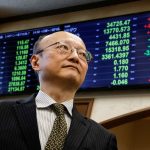
TOKYO (Reuters) – Japan’s top currency diplomat Masato Kanda said he was closely watching how central bank decisions, including an expected end to negative interest rates in Japan, affect markets as speculation over the events could trigger volatile asset moves.
Kanda declined to comment on heightening market expectations that the Bank of Japan (BOJ) will end negative rates in April, saying it was “among important events” that currency authorities were closely watching.
“The timing and pace of U.S. interest rate cuts and the outlook for the BOJ’s policy are drawing strong market attention, and could be used as an excuse for speculative trading,” Kanda said in an interview with Reuters on Wednesday.
“I am always communicating closely with financial authorities, including the BOJ and the Fed. At the same time, we are closely watching the impact each central bank decision has on financial markets, and will continue to do so,” he added.
As vice finance minister for international affairs, Kanda oversees currency policy and has close ties with BOJ executives including Governor Kazuo Ueda.
Kanda oversaw yen-buying currency intervention in 2022 aimed at stemming a sharp yen decline, driven in part by the BOJ’s ultra-loose monetary policy and aggressive interest rate hikes by the U.S. Federal Reserve.
Since becoming BOJ governor in April last year, Ueda has started to dismantle his predecessor’s massive stimulus such as by relaxing its control on long-term interest rates.
Markets expect the BOJ’s next step to be an increase in its short-term rate target from minus 0.1%. While the BOJ kept ultra-loose policy unchanged on Tuesday, it offered the clearest signal to date that an end to negative rates was approaching.
“The BOJ’s ultra-loose monetary policy contributed to pulling Japan out of a state of deflation and reviving an economy,” Kanda said.
“On the other hand, it’s true its long continuation left negative side-effects,” he said, offering a rare voice of caution by an incumbent policymaker over the cost of prolonged monetary easing.
Kanda reiterated that it was desirable for currency rates to move stably reflecting economic fundamentals, though he said exchange-rate intervention was “just one of the many tools we have at our disposal to address excess market volatility”.
Kanda went on to say that the yen’s status as “safe” currency may have weakened.
“The yen is still said to be categorised as safe haven currency along with Swiss franc, though the status seemingly weakened.”
On global economic risk, Kanda said China was likely experiencing intensifying deflationary pressure and a stagnant property market with slowing demand, potentially hurting economies heavily reliant on China-bound exports.
The U.S. economy, on the other hand, was proving to be stronger than expected, increasing the chance of achieving a soft landing, Kanda said.
“The strength of the U.S. economy is underpinning the recovery of the global economy, including that of Japan,” he said.
“If U.S. monetary conditions remain tight for a prolonged period amid high inflation, that could cool consumption and destabilise the corporate sector,” Kanda said.
“If such a risk materialises, that could cool global and Japanese growth. It could also worsen debt problems in emerging economies.”
To read the full article, Click Here

